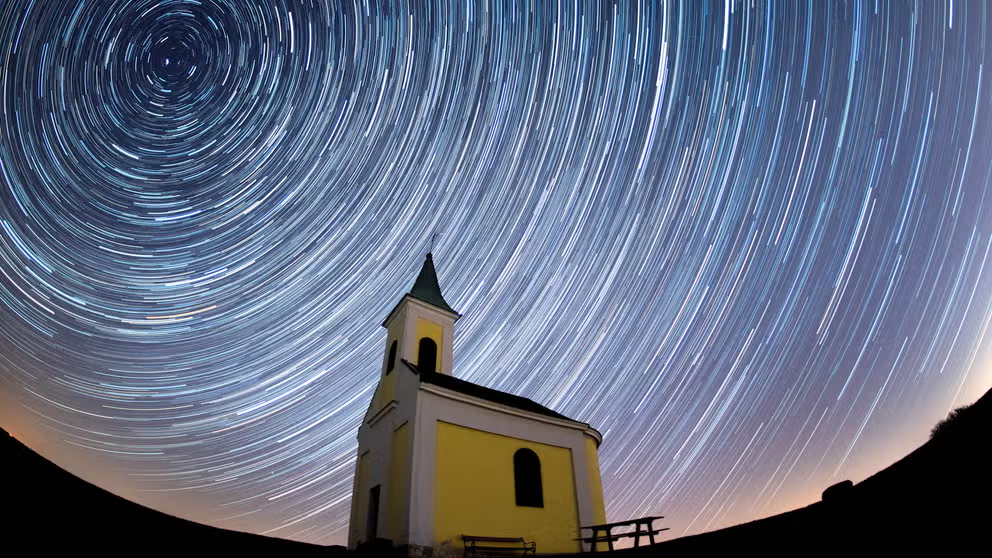Lyrid meteor shower 2023: How and when to see the peak
The Lyrids are one of the oldest known meteor showers. This year, some Americans will be able to see the Lyrids in their full display, while others will have to battle cloud cover.
Meteor showers explained: what to know and how to watch
We call them shooting stars, but it's actually meteors that create dazzling streaks of light across our night sky.
One of the oldest known meteor showers, the Lyrid meteor shower, will peak this month.
The Lyrid meteor shower occurs every April when Earth’s orbit brings the planet into the path of a debris trail left behind by a comet known as comet C/1861 G1 Thatcher. As Earth moves through the debris trail, the debris will appear to fall or "shower" from the sky.
The Lyrids will be active until April 29, but they will peak on the night of April 22 and into the early morning of April 23.
Lyrids appear to come from an area near the constellation Lyra, the namesake for the meteor shower.
When to watch the Lyrids
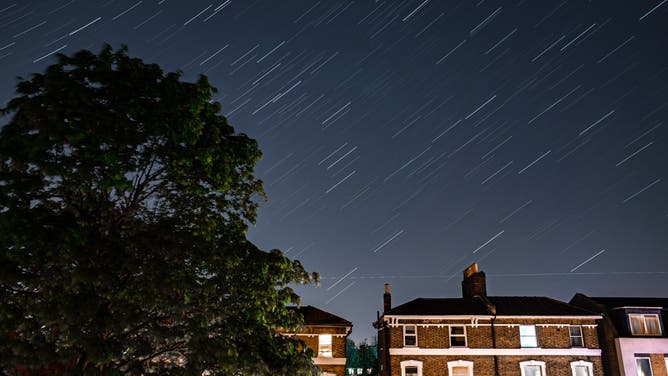
Stars illuminate the sky on a clear night in Forest Hill on April 20, 2020 in London, England. (EDITORS NOTE: Multiple exposures were combined in camera to produce this image.)
(Simon Robling / Getty Images)
On April 22, the Lyrids can be viewed starting at around 10:30 p.m. local time in the U.S., according to the lead for NASA’s Meteoroid Environment Office, William Cooke.
He noted that the Lyrids will peak around 2 a.m. local time in the early morning of April 23.
HERE ARE THE ASTRONOMICAL EVENTS TO WATCH OUT FOR IN APRIL
During this peak period, skywatchers will be able to see about 15 Lyrids per hour, compared to only about five per hour the day before and the day after the peak.
Where to watch the Lyrids
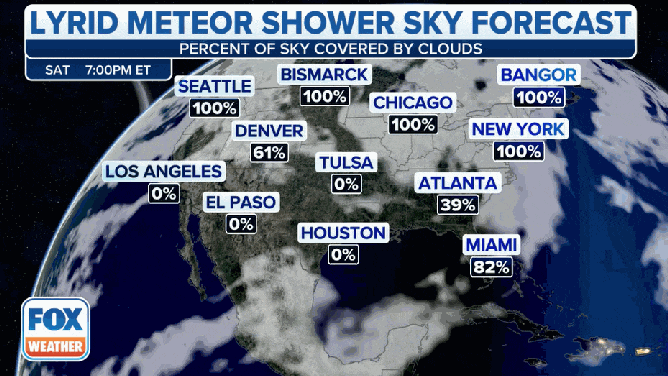
Cloud cover forecast for the Lyrid meteor shower. April 2023.
(FOX Forecast Center / FOX Weather)
For those in the Northeast, cloud cover may impede your sky-gazing experience. For example, folks in New York City and Bangor, Maine, will have 100 percent cloud cover at 10:30 p.m. and 2 a.m. local time.
Skygazers in the Pacific Northwest and parts of the West, won’t have much luck, either. Seattle and Denver will have 100 percent cloud cover at 2 a.m. local time.
Parts of the Midwest and South will have much clearer skies. Houston and Atlanta will have zero percent cloud cover, while Miami will have only 11 percent cloud coverage at 2 a.m. local time.
How to watch the Lyrids
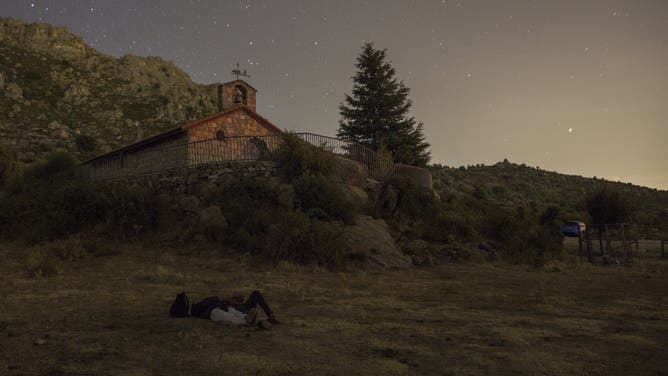
People lie on the ground to watch a meteor shower in Spain. 2020.
(Miguel Pereira / Getty Images)
Skygazers with clear dark skies need only follow a couple of simple steps to view the Lyrid meteor shower.
"Meteor showers are easy. You only need your eyes," Cooke said.
He recommended skygazers find a dark sky, lie flat on their back and look straight up after giving their eyes about 30 minutes to adjust to the darkness.
Speaking of darkness, Cooke advised not looking at cellphones while watching the meteor shower.
"The cell phone screens are bright, and it will ruin your night vision," he said.
Why the Lyrids are different from other meteor showers

The April Lyrids, a meteor shower lasting from April 16 to April 26 each year, is seen over the ancient city of Aizanoi in Kutahya, Turkey on April 23, 2014.
(Fatma Selma Kocabas Aydin / Anadolu Agency / Getty Images)
A number of meteor showers occur throughout the year, and some of them may produce more and brighter fireballs than the Lyrids. So, why should skygazers watch the Lyrids?
One reason is that the Lyrids are unpredictable. Cooke said most years, the Lyrids produce about 15 meteors per hour during their peak, but they sometimes produce more. For example, the Lyrids of April 1982 had about 100 meteors per hour, while the Lyrids of April 1803 produced as many as 300 meteors per hour.
"Every so often, this meteor shower will surprise us," Cooke said. "So every year when the Lyrids roll around, I wonder if they're going to surprise us in terms of rates."
The reason for this unpredictability is tied to the comet the Lyrids come from. According to Cooke, Thatcher is a long-period comet, taking about 415 years to complete its orbit. In contrast, Comet Halley, which produces the more predictable Eta Aquarid and Orionid meteor showers, completes its orbit every six years.
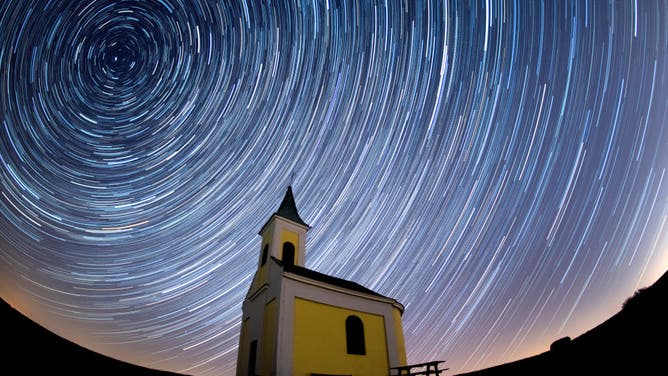
Startrails are seen during the Lyrids meteor shower over Michaelskapelle on April 21, 2020 in Niederhollabrunn, Austria. (EDITORS NOTE: Multiple exposures were combined to produce this image.)
(Thomas Kronsteiner / Getty Images)
Cooke said the cometary models are built around short-period comets, such as Halley, since the long-period comets cannot be observed as often. Because of this, the rate of the Lyrids is unpredictable.
HOW METEOR SMOKE CAN TURN INTO A DAZZLING DISPLAY OF GLOWING CLOUDS AT DUSK
The second reason why folks should watch the Lyrids involves the color of the meteor shower, Cooke said.
Some historical records note a surprising color of the Lyrids. According to Cooke, records in China and Korea describe the Lyrids as red. Additionally, he noted that French monks in April 582 wrote that the sky rained blood.
"Maybe when people go out, they should look for reddish meteors," he said. "I don’t know – the sky raining blood sounds pretty dramatic to me."
Known since ancient times
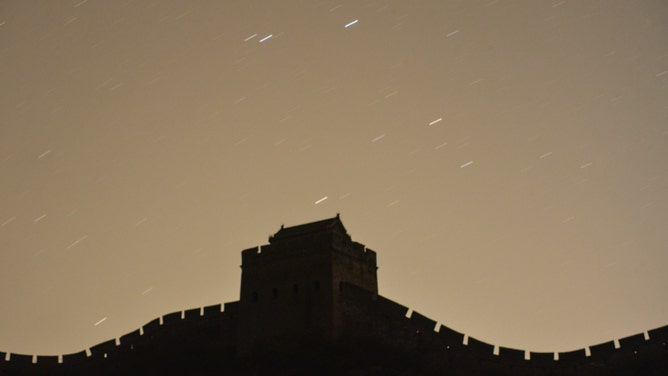
The annual April Lyrids meteor showers illuminate the night sky over the Jinshanling Great Wall on April 22, 2022 in Luanping County, Chengdu City, Hebei Province of China.
(Zhou Wanping / VCG / Getty Images)
The Lyrids are one of the oldest known meteor showers, with the earliest recorded sighting of the meteor shower occurring in 687 B.C. by the Chinese, according to NASA.
In the more than 2,700 years since, the showers have captivated countless other skygazers.
Some of the heaviest showers occurred in Virginia in 1803, Greece in 1922, Japan in 1945 and the U.S. in 1982, NASA said.
